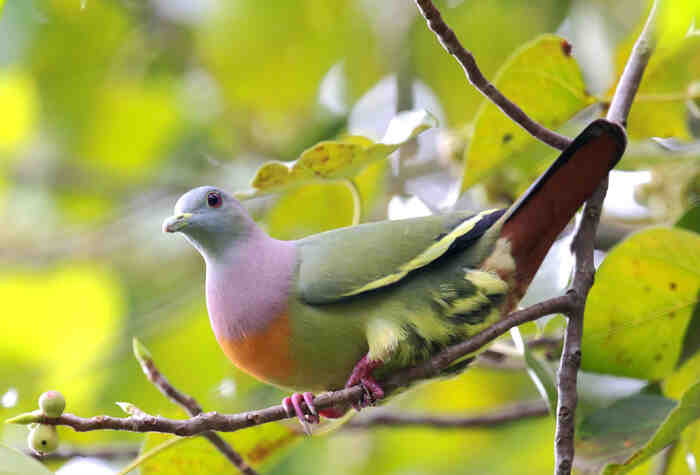Treron bicinctus
IUCN
LCBasic Information
Scientific classification
- name:Treron bicinctus
- Scientific Name:Red-breasted Green Pigeon, Orange-breasted Pigeon, Yellow-breasted Green Pigeon,Treron bicinctus,Orange-breasted Green-pigeon
- Outline:Landfowl
- Family:Columbiformes Columbidae G.Pigeon
Vital signs
- length:24.2-28.5cm
- Weight:135-200g
- lifetime:About 16 years
Feature
A wide reddish-purple band runs across the upper chest, followed by another wider brownish-orange band.
Distribution and Habitat
Distributed in Bangladesh, Bhutan, Cambodia, India, Lao People's Democratic Republic, Malaysia, Myanmar, Nepal, Sri Lanka, Thailand, Vietnam and Java, Indonesia. In China, it is only distributed in Hainan Island and occasionally in Taiwan.
It lives in tropical rainforests and secondary forests in mountains, hills and lowlands.
Appearance
The orange-breasted green pigeon is a small bird. The male has a yellow-green forehead, front eyes and top of the head, blue-gray nape, nape and upper back, brown-green back, shoulder, waist, upper tail coverts and small wing coverts, more brown-brown upper tail coverts, dark gray tail feathers with broad light gray terminal spots and black secondary terminal spots, the latter narrower on the central tail feathers and wider on the outer tail feathers. The middle coverts on the wings are green with a wide yellow edge, and the large coverts on the wings are black, also with a wide yellow feather edge. The cheeks, throat and front neck are green, the chin and the center of the throat are yellow, and the upper chest is crossed by a wide reddish-purple horizontal band, followed by another wider brown-orange horizontal band, which is one of the main differences between it and other green pigeons. The lower chest is light yellow-green, turning bright yellow to the abdomen. The sides of the bo
Details
Orange-breasted Green-pigeon has four subspecies.

Orange-breasted Green-pigeon is mainly a resident bird, usually alone or in small groups of 5-6, and sometimes mixed with other birds. It is most active in the morning and evening. Likes to live on the top branches of dead trees. Its call is a beautiful whistle. It mainly feeds on the fruits of banyan trees, and also eats the fruits and seeds of other plants.
The call of the Orange-breasted Green Pigeon: a rhythmic whistle followed by ko-wrrrook, ko-wrrroook, ko-wrrroook, and a hoarse croak or kreeeew-kreeew-kreeew when warning.
The breeding season of the Orange-breasted Green Pigeon is from April to July. When in heat, it waves its tail feathers up and down, bowing and nodding constantly. It nests in small trees in the forest, and also in taller shrubs and bamboo branches. The nest is very simple, mainly made of thin dead branches. Two eggs are laid in each nest.
During the brooding period, pigeons secrete pigeon milk under the action of prolactin (also known as prolactin) secreted by the posterior pituitary gland. Pigeon milk is composed of fat particles, emulsified fat chyle and lymph fluid secreted by the proliferating flat epithelium of the bilateral lateral sac lymphatic area of female and male pigeons, that is, the crop bed lymphatic area. After the colostrum period, chyle rich in emulsified fat particles is gradually added. The epithelial lymph papilla of the crop bed generally begins to sprout on the 4th to 5th day of the incubation state. The crop bed of male and female pigeons begins to sprout, the blood vessels of the crop bed are congested and thickened, and the lymphatic vessels proliferate. On the 8th to 9th day, the crop epithelium thickens and enters the pre-brooding state. On the 13th day, its thickness and width have doubled. On the 14th-16th day, it can secrete transparent slightly yellow pigeon milk. On the 18th day, the crop can secrete throat milk. However, on the 7th day after the squab hatches, the amount of crop milk secretion begins to decrease, and the secretion stops on the 10th day. It continues to vomit until the chicks are about 2 weeks old, and the crop bed begins to shrink, and the secretion of pigeon milk gradually stops. The semi-finished chyme that is ground by the gizzard and returned from the glandular stomach is gradually mixed into the chyme, and then it becomes a granular feed mixed with water for direct feeding. If the incubated eggs fail to hatch on time, pigeons with good hatching performance can continue to incubate until the 22nd-24th day at most (these are all related to the incubation performance of the pigeon, the hatching season, the feedback of embryonic development information, the frequency of hatching of the fetus, etc. In the cold winter and spring and the brooding period, the incubation period will often be automatically extended, and it is often difficult to persist in the hot and humid days of summer). At this time, the brooding pigeons will automatically stop incubating with the shrinkage of the crop bed.
Listed in the 2013 Red List of Endangered Species of the World Conservation Union (IUCN) ver 3.1 - Least Concern (LC).
Listed in the Level 2 of the List of Wild Animals under National Key Protection in China.
Protect wild animals and stop eating game.
Maintaining ecological balance is everyone's responsibility!








